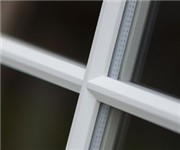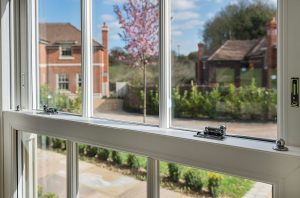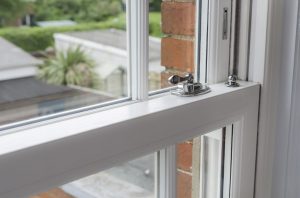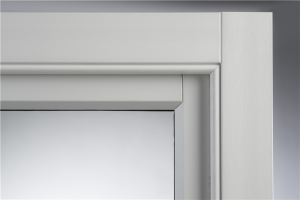Uncategorised
SINGLE GLAZING, DOUBLE GLAZING OR TRIPLE GLAZING?

As manufacturers of sash windows, aesthetics has always played an important role in the design of our windows, because we want to make them identical to the single glazed originals, but as soon as you include a second layer of glass, the aesthetics change, they have too.
This is the reason why English Heritage, wants to preserve (not conserve) the fabric of existing, historically important, buildings, every aspect of the building needs to remain as it is today, or as it was built. They have a duty to preserve the important structural elements from destruction, on behalf of the country, for future generations to come.
Talk of “double glazing” and one immediately has an image of a slick salesman, since the 1980’s with a suitcase of technology to confound their victims and bamboozle innocent home owners into buying something they don’t need or doesn’t work.
Yet the idea technology is not new, it’s not even from the 20th century! One Mr Thomas Stetson first patented the idea of having two sheets of glass, stuck closely together using wood or rope as a spacer, and thatch and tar to make a sealed unit, in 1865.
Double glazing has been around 150 years!
The window tax was introduced in 1696, later in 1746 an additional duty was put on glass until the whole tax was abolished in 1861, just 4 years later, Stetson had patented having two sheets of glass. Whilst one sheet of glass would reduce winds whistling into interior rooms, he saw the additional benefit of the reduction in heat being lost, well before many historic buildings were built.
So why hasn’t every window been made with two sheets of glass ever since?
Well, cost and weight, both probably play a significant part of the problem.
Glass costs.
Glass when it was first invented was more valuable than gold. Glass was incredibly expensive to manufacture and only very small pieces could be produced. As time evolves and glass production simplifies, so the costs are reduced and industrialised processes, “perfect” the glass making process, making it available to the lower classes.
However it is this perfection which purists find objectionable because its reflective qualities are mirror like, it doesn’t refract light and produce distorted reflections like drawn or blown glass offers.
Glass weight
Supporting the weight of glass has always been a challenge. When 3/8th glass (3mm) was used home owners had shutters installed to the outside of properties, to prevent hailstone damage and glass breakage. Thicker drawn glass was stronger, less prone to damage so shutters were no longer needed, but far heavier, requiring sash horns to be invented to help carry the weight.
When mass produced glass becomes affordable and the more recent double glazing market established, so sections had to be beefed up, thicker profiles, extra steel reinforcement, all added costs and weigh to the units being manufactured.
Whilst heat loss was effectively halved, aesthetically windows looked different. No longer the quirky, distorted, imperfect reflection now there would only be a flat, mirrored, sometimes double reflection. What’s more, the edge bar that joins the two sheets of glass would also be visible.
So having three sheets of glass has to be even better than two, doesn’t it?
Think about men’s razor blades. For hundreds of years a single blade has been sufficient; however disposable blades were then introduced and then came the twin blade. “If one blade shaves you close, two blades would save you closer still”, so why do we now have three, even four blades.
The question is, did we need shaves this close, or are we simply the victims of marketing propaganda because manufacturers would want us to believe the improvements are necessary, so that they can sell us a more expensive razor?
We think triple glazing has the same two challenges as before, costs and weights.
Even though glass has reduced in price from the days when it was more than gold, it is still expensive. There is plenty of production, float glass is a very effective process, and there is huge capacity to make more glass.
However Triple glazing increases glass production by 50% (an extra sheet of glass for every two sold today) it doubles the spacer bar meterage required and doubles the possibility of failures (as there are two cavities within the unit not one) so costs have to be more than current twin glass units.
The third sheet of glass also adds 50% more weight to the sealed unit, sunlight has to penetrate three sheets of glass so its less effective at solar gain capture but should retain heat longer. The extra weight of glass has to be supported and most manufacturers have removed steel from their systems to improve thermal efficiencies. Many of the components and profiles have not been designed to carry this additional load, so there will need to be thicker stronger components made, all adding costs.
Then some poor fitter has to lift them!
With H&S advising 25kgs as a maximum single person weight many sash windows already exceed 50, 60 even 100 kgs, adding 50 % to these will change distribution methods and safe handling in factories and on site too.
Using industry information and our own in-house thermal modelling calcutaions, we know that a triple glazed sash window, with a u-value of 1.2, reduced the WER from an A rated product to a D rated product, mainly because triple glazing did not allow much solar gain.
An additional consideration is that gas filled units work best with an 8mm gap, air filled units needed 20mm gap for optimum efficiencies and triple glazing requires approx 40mm between each sheet of glass to be most effective.
Therefore on new build, where the sections can accommodate thick sealed units of 60/80mm, then without doubt triple glazing is very effective, but if three sheets of glass are to be used, and the sections can accommodate them being forced into an existing glazing rebate of 20 or 24mm, then the improvement is marginal and much worse if solar gain is a consideration.
Masterframe sash windows can be made with triple glazing but there are some serious considerations to take into account before spending extra money on something that may not increase efficiencies at all or only offer marginal increases that thick curtains would offer!




